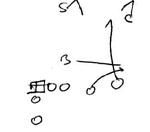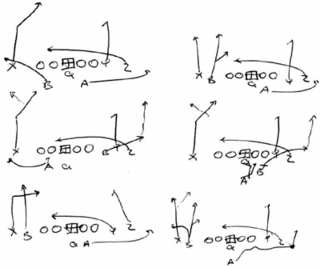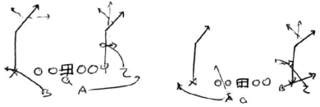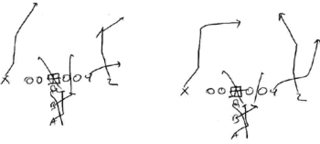As discussed in the last article, sending all your receivers vertically is often very difficult to pattern read for zone defenders, safeties, as well as the very disruptive rovers/floaters. However, any quick look at the football landscape reveals that many, many teams successfully use lots of shallow crosses and flat routes. Given the discussion and some doodling on paper this is a surprise. These routes are almost silly: aside from being simple to jump and wall off for many defenders, they often give away what the one or two vertically releasing receivers will do.
However, my point is not that these routes are irrelevant, yet teams should be careful how they use them and it is possible that they are overused. For example, many coaches teach the passing game based on the reaction of one defender. For example, on the curl/flat combination shown below, the coach will say that if the linebacker widens with the flat, throw the curl. However, if the defense wants to, it can always double cover the curl and cover the flat one on one and take it away.

So, briefly, why do teams run these types of routes? Of first importance is who they are run against; often it is linebackers and safeties, who are weaker pass defenders. Second, the throws themselves are often easier than other throws, which can require more timing and the ability to squeeze the ball between defenders--many of these throws are simply underneath defenders.
Third, structurally, they are easy to understand and often easy to read. While this is a fear if the defense is too good, again, simplicity often favors the offense. If I send a player immediately to the flat, then I can quickly see the defense's reaction. If I send two receivers vertical it is not apparent to the QB who the D will eventually leave uncovered.
Lastly, while they (usually) are poor at threatening vertically, they can still be packaged together to create rubs, picks, and mismatches. Whether in the traditional bunch set or simply a shoot route by a running back versus a slower linebacker, we can all envision circumstances that make them effective. Therefore these routes, often better than 3 or 4 vertically releasing receivers are good at causing the defense to put itself in a numbers bind (I.E. three defenders to cover two receivers or four defenders to cover three receivers. This is what can win football games from a strategy point of view.) The point of this article is to show some of the right ways to use them and some of the proper considerations.
I'll begin with the shallow cross series as I have run it, which has a few variations and has come under a few names, including the West Coast "drive" concept, or just shallow cross in mine. It is a simple inside-out read for the QB, who reads the shallow cross, to a curl or in-breaking route, to the flat (or sometimes a wheel route). Sometimes there are backside reads as well, but for now I will just show it with a post route and a backside flat to control the outside linebacker for the crossing receiver.

In the lower left is how Purdue runs the play, which is basically the same even if the techniques are slightly different.
However, no matter how you dress it up, the play does not exist in a vacuum. In my earlier article I talked about the same plays being run from multiple formations. Yet, the D cannot be totally fooled if every time one guy comes in, another pushes vertical, and another goes to the flat. It simply becomes recognition and reaction for the defense; in other words they can pattern read you.
Quickly, I'll show a few other combinations of routes that look similar. First, the now famous mesh/snag/triangle route:

And the follow/angle combination:

Shallow, snag, and follow (which is what I call them--insert Shakespeare's famous question here) form what I call the "Holy Trinity", which are imperative for any good passing team, particularly if you plan to use the bunch packages. Intuitively, you can see the advantage to using these together, but it becomes more apparent if I draw it first as what the stems look like on each play, and then as a branch of possibilities:

Since that looks a bit messy, here is each route individually:

The defense cannot pattern read anymore, because every play is like a kind of dynamic route tree. You've achieved the same equilibrium with these short routes as you had when all your receivers vertically released.
In this case you can still get double teamed, but they will be unable to jump the underneath routes for fear that a shallow may become a whip or that a shoot route may become a wheel or an angle route.
Conclusion
All this is part of making your offense cohesive. Again, no play exists in a vacuum. You do this for the same reason that you run draw plays or that you run your play action passes off of your favorite run plays instead of plays you don't even run. They keep the defense honest and make you difficult to defend. If I have five pass plays but they all look markedly different, I become easier to defend. If I can mix in all the formations, substitutions, and then, even if the defense accurately reads run or pass and can identify the receivers, yet still can't tell if there is a whip or a shallow coming, or a corner or a curl (or a post), then I have been successful.
It doesn't really matter how you integrate it into your system, whether they are separate plays or tags or whatnot, but the important thing is to make it difficult for the D and easy to teach. For the last two diagrams I will show you how Spurrier integrates this same idea into his two favorite pass plays (which, to add to the confusion, are built off his favorite run play, the lead draw).
First, Spurrier loves the curl/corner read play, which I discussed in this article and the common dig/post pass, shown below:

Laid on top of each other, it looks like this to the defense:

He's been doing this for years. Constant three way threats all around, the threat of multiple vertical receivers, including post and corner routes, are all staples of the Old Ball Coach's offense.




3 comments:
Chris: Nice synthesis! Those superimposed route diagrams are worth their weight in gold...
Chris, great article. i am new to the site. Can you go through the read concept for the QB on these routes. I need to keep it simple for my HS QB.
thanks.
hc20
I know I am really late to your party Chris, but the info on this website is phenomenal. I leave it up when I'm re-tooling my playbook for next year.
Side note: look-up CoachBook online a new "Facebook" for coaches and feel free to drop more knowledge on us/me CoachK15
Post a Comment